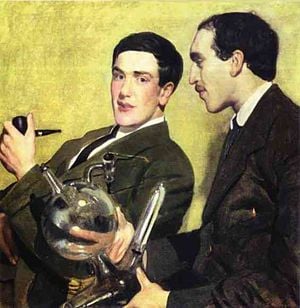Pyotr Kapitsa
Pyotr Leonidovich Kapitsa (Russian Пётр Леонидович Капица) (July 9, 1894 – April 8, 1984) was a Russian physicist who discovered superfluidity with contribution from John F. Allen and Don Misener in 1937.
Kapitsa was born in the city of Kronstadt, Russia, and graduated from the Petrograd Polytechnical Institute in 1918. He worked in the Cavendish Laboratory in Cambridge with Ernest Rutherford for over 10 years, was made a Fellow of the Royal Society in 1929, and was the first director of the Mond Laboratory from 1930 to 1934. During this period, he originated techniques for creating ultrastrong magnetic fields by injecting high currents into specially constructed air-core electromagnets for brief periods of time. In 1934 he developed a new and original apparatus for producing significant quantities of liquid helium, based on the adiabatic principle.
In 1934 he was on a professional visit to the Soviet Union when his passport was detained and he was not permitted to leave the country. Kapitsa was required to form the Institute for Physical Problems, with equipment purchased by the Soviet Government from the Mond Laboratory in Cambridge with the assistance of Rutherford, once it was clear that Kapitsa would not be permitted to return to England. Kapitsa is also one of the founders of Moscow Institute of Physics and Technology.
In August 1946, Kapitsa was removed from his role as head of the institute he created and exiled to his dacha near Moscow, over his refusal to take part in the Soviet Hydrogen Bomb project. In a letter to Stalin, Kapitsa described the project's leader, Lavrenty Beria, as "like the conductor of an orchestra with the baton in hand but without a score". After Stalin's death he regained his position, and remained director of the institute until 1984. At his death in 1984 he was the only member of the presidium of the Soviet Academy of Sciences who was not a member of the Communist Party.
Kapitsa won the Nobel Prize in Physics in 1978 for his work in low-temperature physics. He shared the prize with Arno Allan Penzias and Robert Woodrow Wilson (who won for unrelated work).
Kapitza resistance is a resistance to the flow of heat across the interface between liquid helium and a solid that produces a temperature discontinuity.
External links
- Pyotr Leonidovich Kapitsa: Official Nobel page
- Annotated bibliography for Peter Kapitza from the Alsos Digital Library for Nuclear Issues
| ||||||||||||||||||||
Credits
New World Encyclopedia writers and editors rewrote and completed the Wikipedia article in accordance with New World Encyclopedia standards. This article abides by terms of the Creative Commons CC-by-sa 3.0 License (CC-by-sa), which may be used and disseminated with proper attribution. Credit is due under the terms of this license that can reference both the New World Encyclopedia contributors and the selfless volunteer contributors of the Wikimedia Foundation. To cite this article click here for a list of acceptable citing formats.The history of earlier contributions by wikipedians is accessible to researchers here:
The history of this article since it was imported to New World Encyclopedia:
Note: Some restrictions may apply to use of individual images which are separately licensed.
